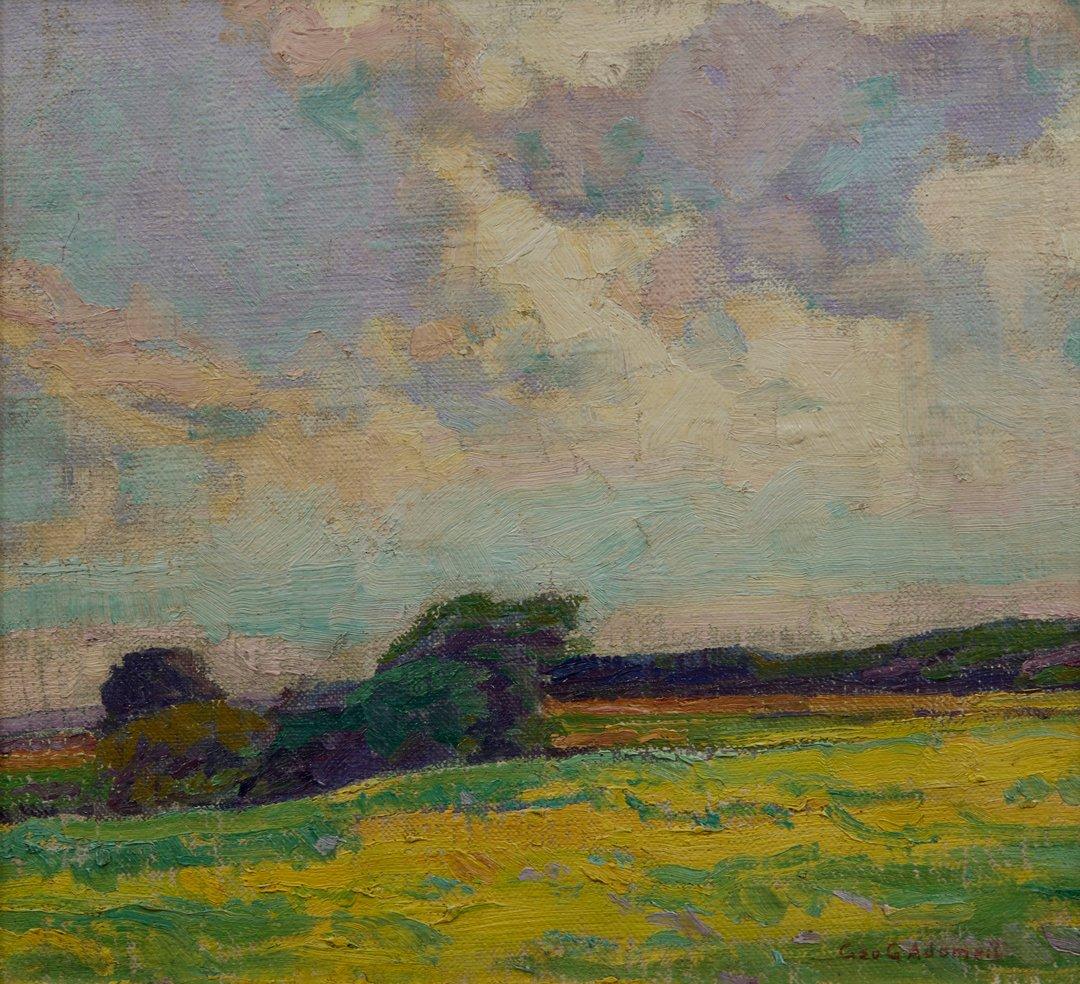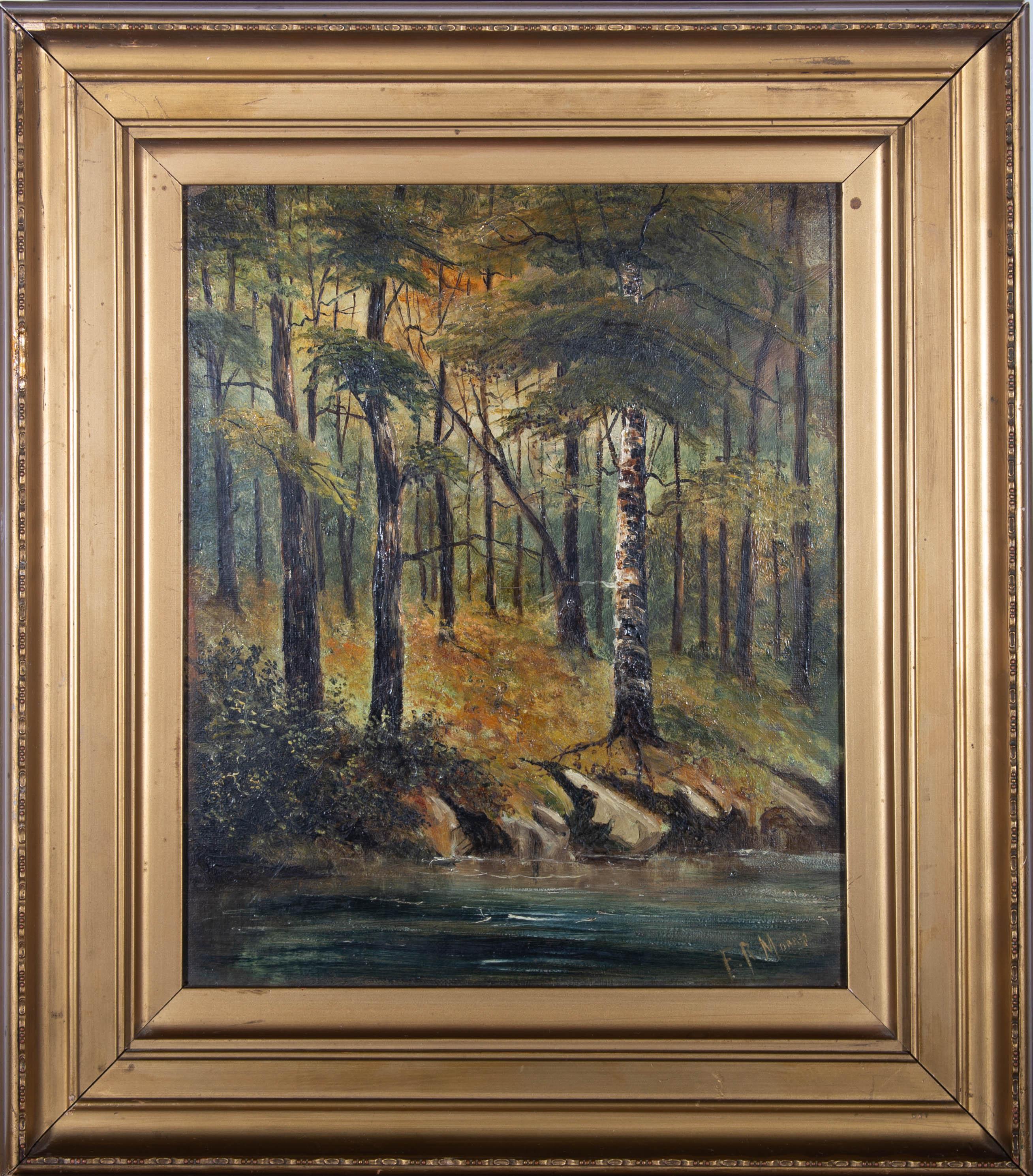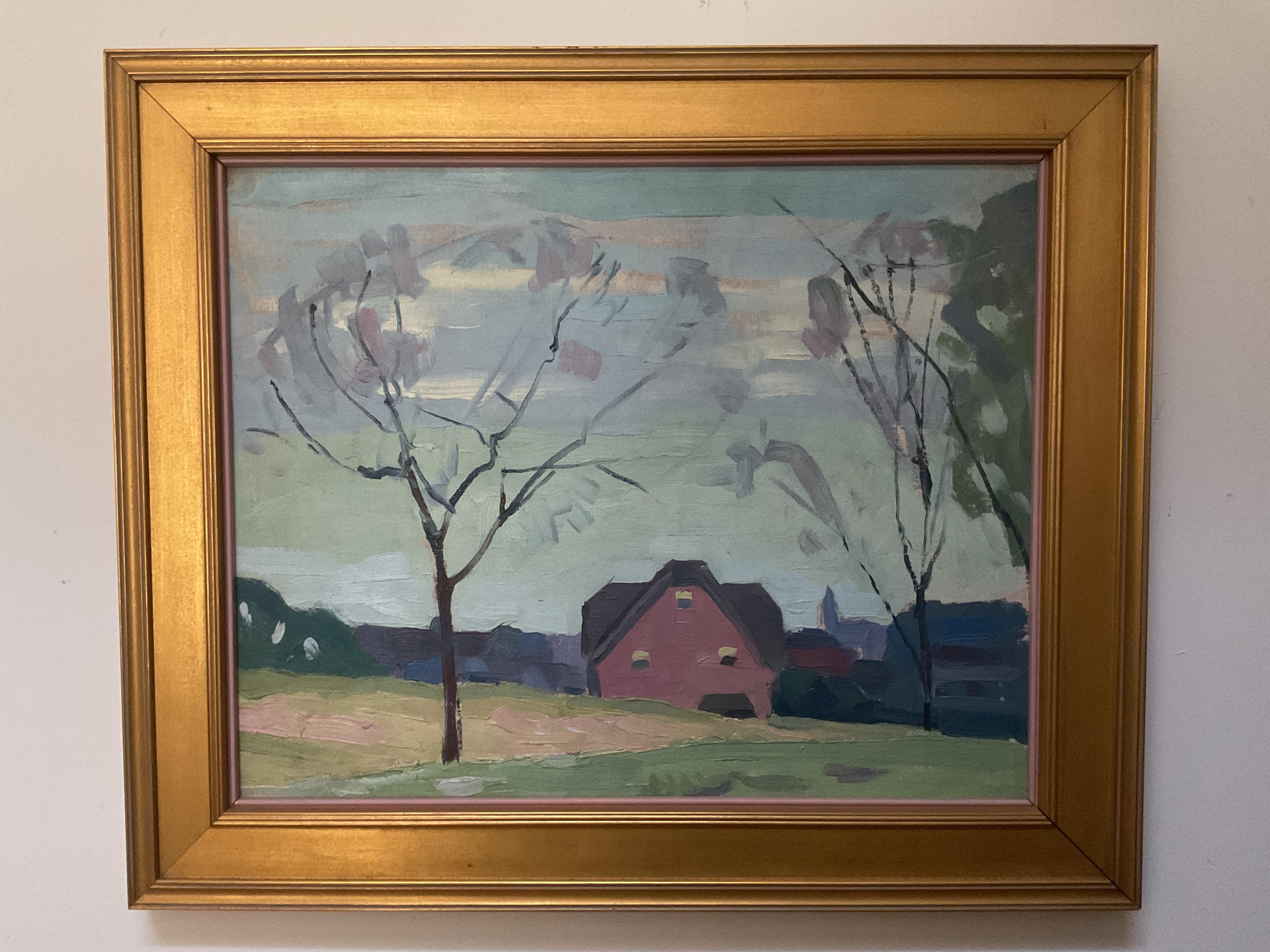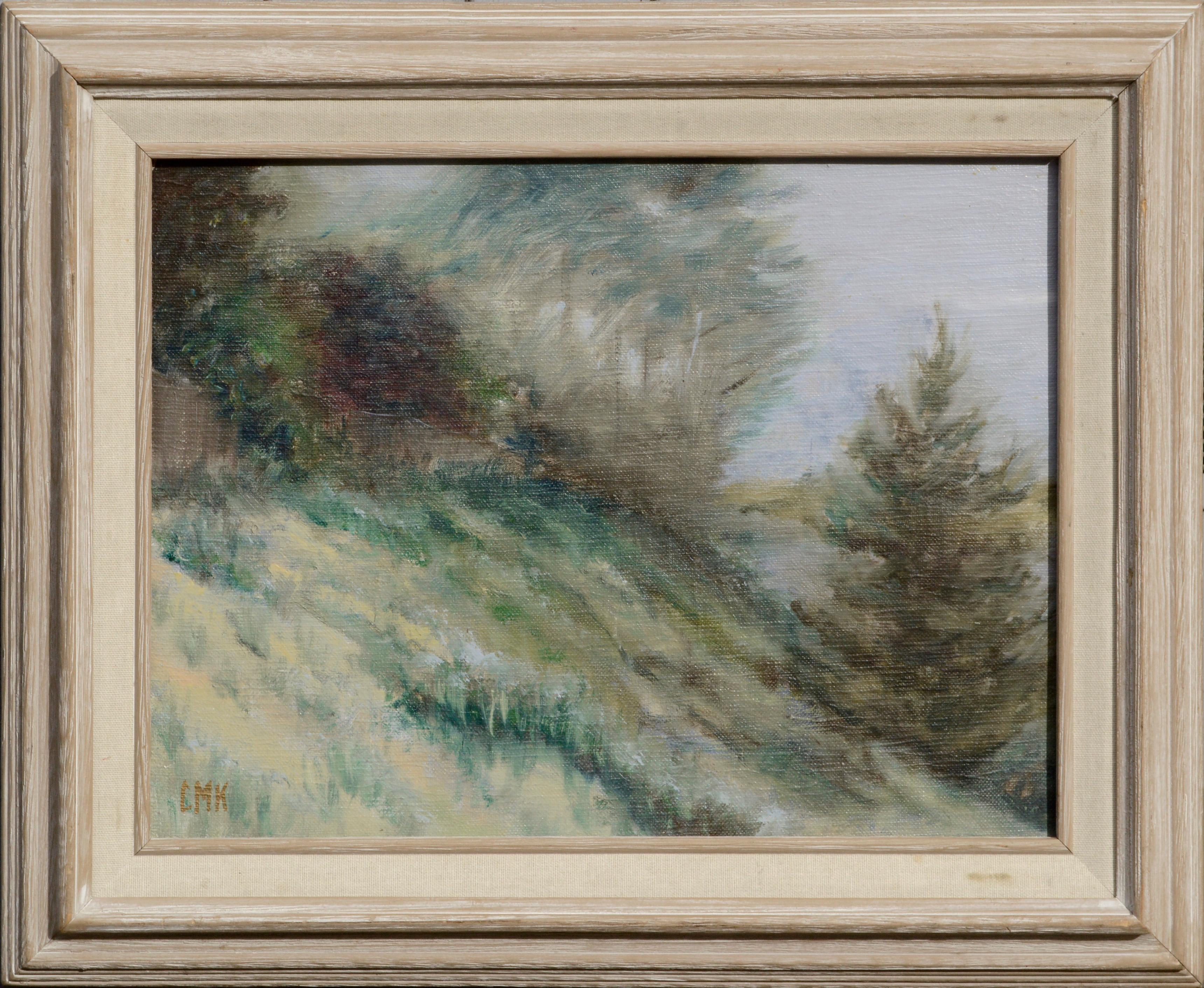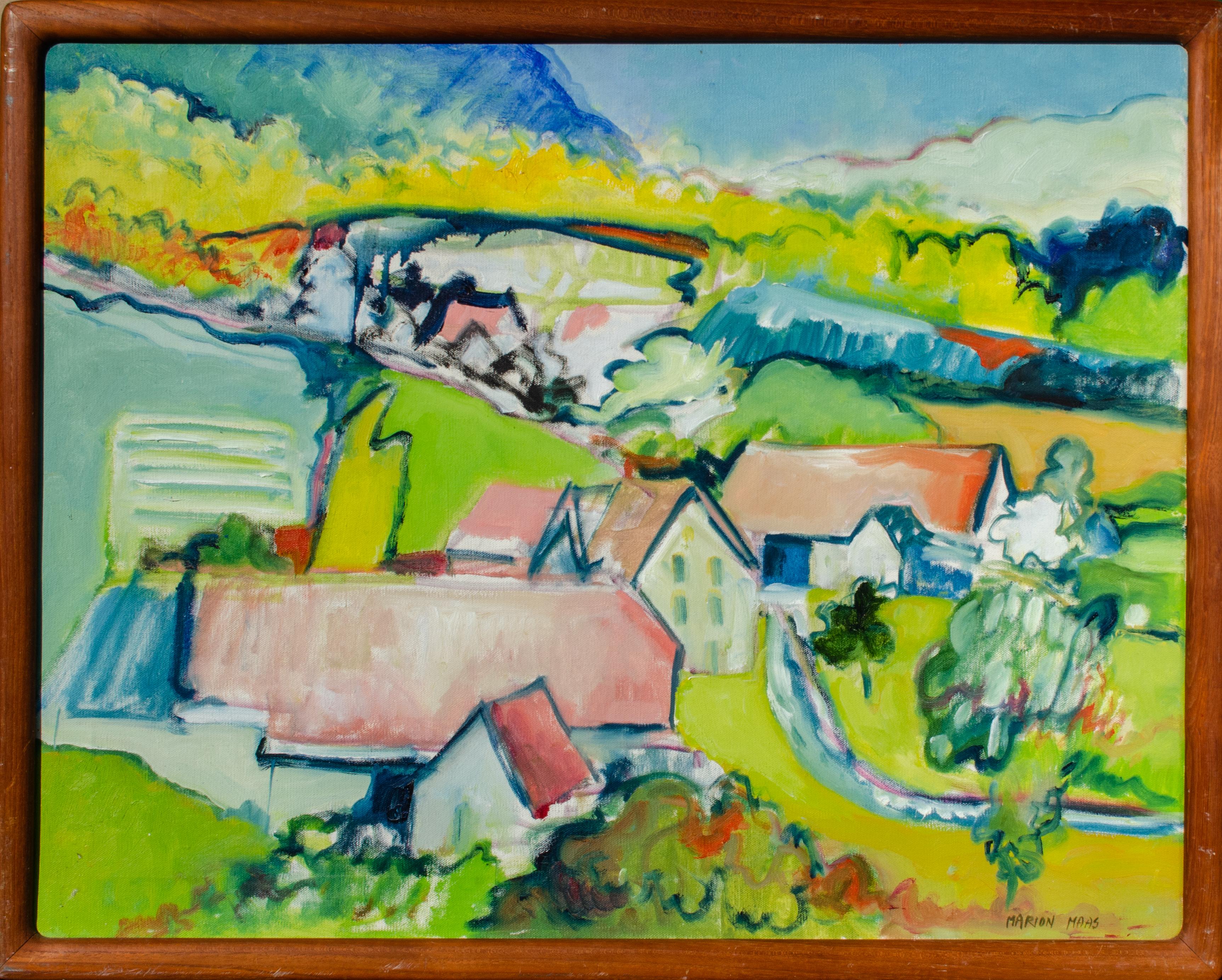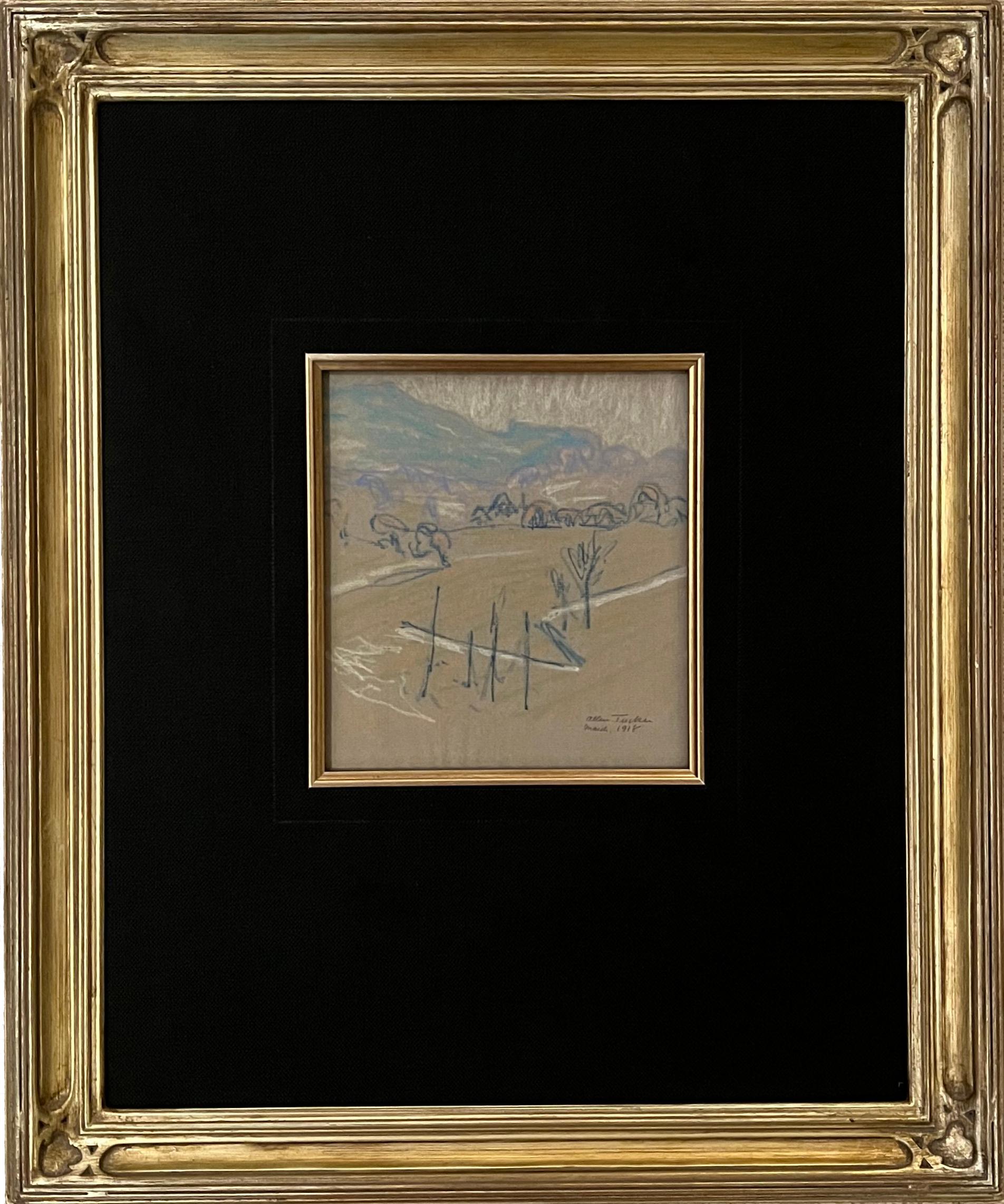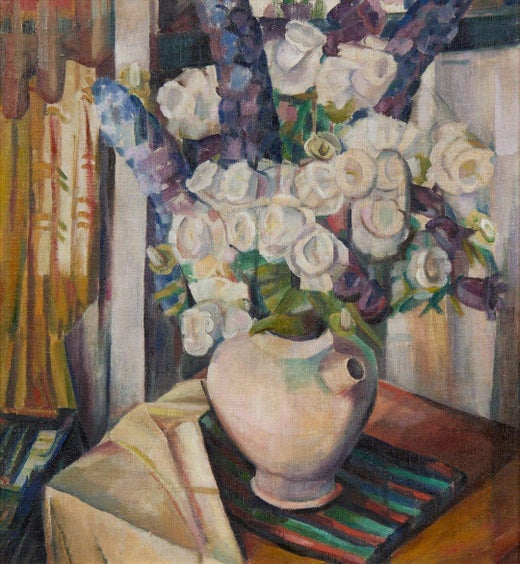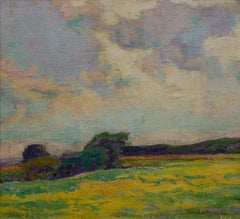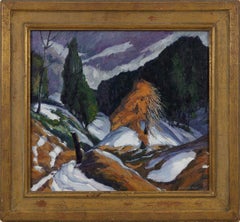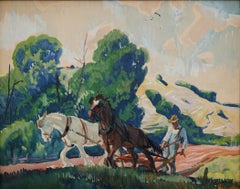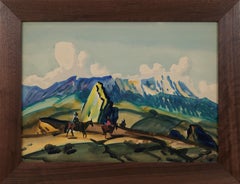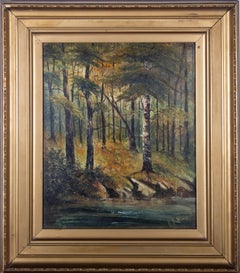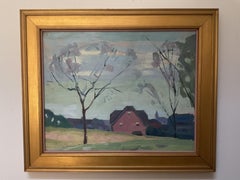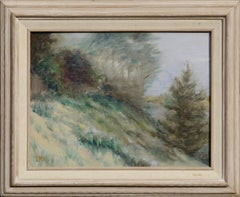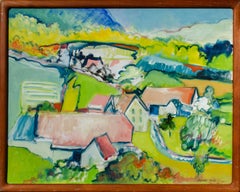Items Similar to Hillside and Stream, early 20th century modernist Cleveland School painting
Video Loading
Want more images or videos?
Request additional images or videos from the seller
1 of 11
Clara DeikeHillside and Stream, early 20th century modernist Cleveland School painting1916
1916
$15,000
£11,313.88
€13,067.64
CA$21,016.03
A$23,368.62
CHF 12,233.90
MX$285,452.10
NOK 153,730.96
SEK 144,614.77
DKK 97,549.02
About the Item
Clara Deike (American, 1881-1964)
Hillside and Stream, 1916
Gouache on paper
Signed and dated lower right
22 x 18 inches
25.5 x 21.5 inches, framed
A graduate of the Cleveland School of Art in 1912, Clara Deike was part of the watercolor movement in Northeast Ohio whereby the outdoor sketch became a distinct genre. The group formed the Cleveland Watercolor Society in 1894, and members typically painted outdoors during the summer, enjoying watercolor for its fast-drying properties.
She was a student of Henry Keller, 1869-1949, the first Ohio artist to attain distinction as a watercolorist. With him, she developed a modernist style but she utilized his color theories and went further with her own personalized style that emphasized two-dimensional, decorative design. She often used opaque gouache because of its capacity to give the appearance of flattened forms.
Her art training was later supplemented by study with Hans Hoffman in Munich and Capri and with Diego Rivera in Mexico. Her style ranged from still lifes and landscapes to abstract experimentation in her later years.
A founding member of the Woman's Art Club of Cleveland, Deike served as the group's president in 1919-20. Never married, she maintained studios in her Lakewood residence and in a summer home in Gloucester, Mass.
- Creator:Clara Deike (1881 - 1964, American)
- Creation Year:1916
- Dimensions:Height: 22 in (55.88 cm)Width: 18 in (45.72 cm)
- Medium:
- Movement & Style:
- Period:
- Condition:
- Gallery Location:Beachwood, OH
- Reference Number:1stDibs: LU1768214072702
undefined
About the Seller
5.0
Platinum Seller
Premium sellers with a 4.7+ rating and 24-hour response times
Established in 1975
1stDibs seller since 2022
37 sales on 1stDibs
Typical response time: <1 hour
- ShippingRetrieving quote...Shipping from: Beachwood, OH
- Return Policy
Authenticity Guarantee
In the unlikely event there’s an issue with an item’s authenticity, contact us within 1 year for a full refund. DetailsMoney-Back Guarantee
If your item is not as described, is damaged in transit, or does not arrive, contact us within 7 days for a full refund. Details24-Hour Cancellation
You have a 24-hour grace period in which to reconsider your purchase, with no questions asked.Vetted Professional Sellers
Our world-class sellers must adhere to strict standards for service and quality, maintaining the integrity of our listings.Price-Match Guarantee
If you find that a seller listed the same item for a lower price elsewhere, we’ll match it.Trusted Global Delivery
Our best-in-class carrier network provides specialized shipping options worldwide, including custom delivery.More From This Seller
View AllEarly 20th Century Summer Landscape, Cleveland School Artist
By George Adomeit
Located in Beachwood, OH
George Gustav Adomeit (American, 1879-1967)
Summer Landscape
Oil on canvas board
Signed lower right
13 x 14.25 inches
18.25 x 19.5 inches, framed
A major painter of American scene s...
Category
Early 20th Century American Modern Figurative Paintings
Materials
Oil
Scrub and Pines, Early 20th Century Landscape, Cleveland May Show Exhibition
By William Grauer
Located in Beachwood, OH
William C. Grauer (American, 1895-1985)
Scrub and Pines, 1929
Oil on canvas
Signed lower right
18 x 20 inches
24.5 x 26.5 inches, framed
Exhibited: Cleveland Museum of Art, May Show ...
Category
1920s Figurative Paintings
Materials
Oil
Plowman, Brecksville, Ohio, Early 20th Century Farm Landscape, Cleveland School
By Frank Wilcox
Located in Beachwood, OH
Frank Nelson Wilcox (American, 1887–1964)
Plowman, Brecksville, Ohio, c. 1922
Watercolor on paper
Signed lower right
22.5 x 27.75 inches
27.75 x 34.5 inches, framed
Frank Nelson Wilcox (October 3, 1887 – April 17, 1964) was a modernist American artist and a master of watercolor. Wilcox is described as the "Dean of Cleveland School painters," though some sources give this appellation to Henry Keller or Frederick Gottwald. Wilcox was born on October 3, 1887 to Frank Nelson Wilcox, Sr. and Jessie Fremont Snow Wilcox at 61 Linwood Street in Cleveland, Ohio. His father, a prominent lawyer, died at home in 1904 shortly before Wilcox' 17th birthday. His brother, lawyer and publisher Owen N. Wilcox, was president of the Gates Legal Publishing Company or The Gates Press. His sister Ruth Wilcox was a respected librarian.
In 1906 Wilcox enrolled from the Cleveland School of Art under the tutelage of Henry Keller, Louis Rorimer, and Frederick Gottwald. He also attended Keller's Berlin Heights summer school from 1909. After graduating in 1910, Wilcox traveled and studied in Europe, sometimes dropping by Académie Colarossi in the evening to sketch the model or the other students at their easels, where he was influenced by French impressionism. Wilcox was influenced by Keller's innovative watercolor techniques, and from 1910 to 1916 they experimented together with impressionism and post-impressionism. Wilcox soon developed his own signature style in the American Scene or Regionalist tradition of the early 20th century. He joined the Cleveland School of Art faculty in 1913. Among his students were Lawrence Edwin Blazey, Carl Gaertner, Paul Travis, and Charles E. Burchfield. Around this time Wilcox became associated with Cowan Pottery.
In 1916 Wilcox married fellow artist Florence Bard, and they spent most of their honeymoon painting in Berlin Heights with Keller. They had one daughter, Mary. In 1918 he joined the Cleveland Society of Artists, a conservative counter to the Bohemian Kokoon Arts Club, and would later serve as its president. He also began teaching night school at the John Huntington Polytechnic Institute at this time, and taught briefly at Baldwin-Wallace College.
Wilcox wrote and illustrated Ohio Indian Trails in 1933, which was favorably reviewed by the New York Times in 1934. This book was edited and reprinted in 1970 by William A. McGill. McGill also edited and reprinted Wilcox' Canals of the Old Northwest in 1969. Wilcox also wrote, illustrated, and published Weather Wisdom in 1949, a limited edition (50 copies) of twenty-four serigraphs (silk screen prints) accompanied by commentary "based upon familiar weather observations commonly made by people living in the country."
Wilcox displayed over 250 works at Cleveland's annual May Show. He received numerous awards, including the Penton Medal for The Omnibus, Paris (1920), Fish Tug on Lake Erie (1921), Blacksmith Shop (1922), and The Gravel Pit (1922). Other paintings include The Trailing Fog (1929), Under the Big Top (1930), and Ohio Landscape...
Category
1920s American Modern Figurative Drawings and Watercolors
Materials
Watercolor
Nearing the Peaks, Early 20th Century Mountainous Western Landscape
By Frank Wilcox
Located in Beachwood, OH
Frank Nelson Wilcox (American, 1887–1964)
Nearing the Peaks, 1937
Watercolor on paper
Signed and dated lower right
15 x 20 inches
18.5 x 24 inches framed
Frank Nelson Wilcox (Octo...
Category
1930s American Modern Landscape Drawings and Watercolors
Materials
Watercolor
Abstract Landscape, large mid-century green painting, COBRA art movement
Located in Beachwood, OH
Erik Ortvad (Danish, 1917 - 2008)
Abstract Landscape, 1946
Oil on canvas
Signed and dated lower right
32 X 37.5 inches
35 x 40.5 inches, framed
Born in 1917 in Copenhagen, Erik Ortvad was a surrealist painter and a founding member of the COBRA art...
Category
1940s Abstract Impressionist Abstract Paintings
Materials
Oil
The Adobe, Early 20th Century Western Village Landscape, Cleveland School Artist
By Frank Wilcox
Located in Beachwood, OH
Frank Nelson Wilcox (American, 1887–1964)
The Adobe, c. 1940-41
Watercolor on paper
Signed lower right
14 x 20 inches
18.5 x 24 inches framed
Frank Nelson Wilcox (October 3, 1887 –...
Category
1940s American Modern Landscape Drawings and Watercolors
Materials
Watercolor
You May Also Like
F. R. Morris - 20th Century Oil, The Hillside
Located in Corsham, GB
This atmospheric scene depicts woodland on the verge of a river. The artist has captured the trees and foliage in fine detail, using a slight impasto technique to capture the various...
Category
21st Century and Contemporary Landscape Paintings
Materials
Oil
$261 Sale Price
20% Off
American Modernist Town Scene Painting by Pennsylvania artist Joseph M. Plavcan
Located in Baltimore, MD
This colorful late spring scene is most likely around Erie, Pennsylvania. Artist and teacher Joseph M. Plavcan generally painted around the area in which he lived for over 50 years.
Joseph Michael Plavcan was born near Pittsburg, in Braddock. He attended the Pennsylvania Academy in 1926, studying with renowned New Hope artist Daniel Garber. Through a scholarship, he went to Europe to study. He returned to Erie in 1932 and became an art instructor, teaching for the next 38 years. Plavcan went far beyond teaching trade school requirements and instilled a true sense of sophisticated artistry in his students. During his artistic career, he exhibited often in Philadelphia, Washington, New York and Chicago.
This painting, oil on canvas, demonstrates Plavcan’s style, utilizing figurative abstraction with a modernist color palette. The paint is not over applied and areas are treated with smooth broad brush strokes. The hint of late blooming leaves are dashes of paint applied in a fast yet confident manner. Plavcan’s sense of light, demonstrated in the distant church tower is spot on.
While not signed, there are two official estate stamps on the reverse that attest to the authenticity of Plavcan’s work. The piece measures 16” x 20” and appears to be canvas applied to a back board. This was likely done by the former retailer, Hudson House Galleries in Hagerstown, Maryland. That shop was a fine regional art gallery and antiques shop for decades until its closure about five years ago. The painting is nicely framed in a modernist gold wood frame with a subtle pink liner. The overall framed dimensions are about 20” x 24”. The painting is in very good condition, bright and crisp. There is a very minor vertical crease above the peak of the house that is truly barely noticeable from any distance. Other than that, all is fine with the work and its frame.
This strong, colorful work by Joseph Plavcan...
Category
1960s American Modern Landscape Paintings
Materials
Oil
Hillside Landscape
Located in Soquel, CA
Misty and verdant small-scale landscape by an unknown artist ("CMK"). The composition of the hillside in this landscape creates a diagonal across the canvas, bringing more visual int...
Category
1990s American Impressionist Landscape Paintings
Materials
Canvas, Oil, Cardboard
Modernist Hillside Painting by Marion Maas
Located in New York, NY
Marion Maas (American, b. 1930)
Untitled, c. 1980s
Oil on canvas
21 7/8 x 27 1/2 in.
Framed: 23 1/2 x 29 1/4 x 1 in.
Signed lower right
Landscape, figurat...
Category
1980s Contemporary Figurative Paintings
Materials
Canvas, Oil
Hillside pastel by Allen Tucker
By Allen Tucker
Located in Hudson, NY
Hillside (1918)
Pastel on grey paper
8 ½"x7 ¾"
23 ½" x 19 ½" x 1 ½"
signed "Allen Tucker March 1918" lower right.
Provenance: Gift from the artist to his friend Una Brage, USA/Switzerland, in the 1930s.
Estate of Ms. Brage to her friend Jean Corbett Peck, daughter of architect Harvey Wiley Corbett.
By descent to her daughter
About this artist: Allen Tucker, was an architect and painter so influenced by Vincent Van Gogh that he was called "Vincent in America". (Gerdts 291) Robert Henri and Maurice Prendergast were also credited as having an influence on Tucker's brushwork and compositions, the latter decisively. However, as his painting evolved, he did not fit into any tidy slot for description and was known as an individualist not easily categorized in American art history.
Tucker was born in Brooklyn in 1866 and graduated from the School of Mines of Columbia University with a degree in architecture and took a job as an architectural draftsman in the architectural firm of McIvaine and Tucker, his fathers business. During that time, he studied painting at the Art Students League with Impressionist John H...
Category
Early 20th Century Modern Drawings and Watercolor Paintings
Materials
Paper, Pastel
Landscape
Located in San Francisco, CA
This artwork " Landscape " 1939 is a watercolor on paper by noted California (German/American) artist Ernst Stolz, 1901-1989. It is signed and dated at the lower right corner by the ...
Category
Mid-20th Century American Impressionist Landscape Drawings and Watercolors
Materials
Watercolor
